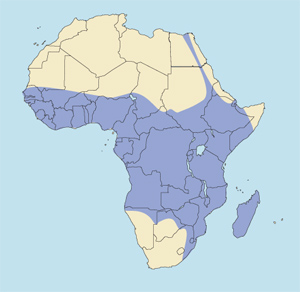 |
Crocodylus niloticus
DESCRIPTION The Nile crocodile is by far the largest in Africa, averaging 11-1/2 feet (3.5 m) in length, very occasionally to around 16-1/2 feet (5 m), and sometimes even more.
BEHAVIOR Spends much of the day basking in the sun at water's edge in order to maintain its preferred body temperature of 75 degrees F. (25 degrees C.). When overheated, it seeks shade or partly submerges. Returns to the water at dusk, for early evening is its most active period. Eats mainly fish, though large adults routinely capture antelopes and domestic animals that come to drink, even animals as large as Cape buffalo. Birds are frequently eaten, as are snails, small mammals and sometimes humans. Does not require large quantities of food. The Nile crocodile is a hole-nesting species, in which the female lays its eggs in holes excavated by its hind legs, and tends to return to the same hole each year. The male and female cooperate in protecting their young for six to eight weeks after hatching.
DISTRIBUTION Most of Africa south of the Sahara where there is permanent water, except where it has been eliminated by commercial hide hunting or human settlement. In northeastern Africa it is absent from the Red Sea coast, from Djibouti, and from much of Ethiopia and Somalia. In southern Africa it is absent from Namibia except for the Cunene River, from most of Botswana except for the Okavango and Kwando-Chobe swamps, and from much of South Africa except for Zululand and parts of the Transvaal.
REMARKS A large crocodile is a worthy quarry and has long been regarded as a big game trophy by sportsmen. When hunted by sporting methods (as contrasted with commercial hunting, which is normally conducted at night with boats and spotlights) it can be a challenging game animal, for its senses are good and it has learned to be wary. It requires a careful stalk and a precise brain shot-often at rather long range-in order to anchor it so that it will not slide into deep water and be lost.
STATUS Listed as threatened by the USF&WS. Listed on Appendix I of CITES, except for the populations in Botswana, Ethiopia, Kenya, Malawi, Mozambique, South Africa and Zambia; and in Zimbabwe, subject to ranching provisions; and in Tanzania, subject to ranching provisions and annual quotas; and in Uganda and Madagascar, subject to export quotas.
|





